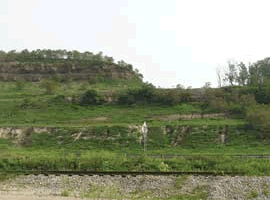West Virginia Highway 47 Cut ~ ph Problem
Theisen notes that once the pH problem was identified, he knew that it had to be lowered substantially. Another question that remained was what kind of seed mix to use. Drawing on the combined experience of the West Virginia DOT; the Department of Natural Resources (with its experience in difficult mine reclamation projects); Profile Products’ in-house agronomists; and its local contractor, Penn Line Service, an interesting seed mix was developed. Several different seed types were utilized, including orchard grass, birdsfoot trefoil, redtop grass, switchgrass, perennial rye, and alsike clover. Perhaps the most surprising part of the mix, however, was the inclusion of Bermuda grass.

Bermuda grass is rarely used in that part of the country, Theisen explains, because it favors a warmer climate. It is also not often used on such steep slopes. Zwilling made the call to include Bermuda grass, however, because at the time of application, they were entering a hotter part of the year and Bermuda is more drought-resistant than many other grasses. Zwilling was concerned that there might not be sufficient rainfall to nurture the growth of the predominantly cool-season seed mix. He also had another reason to use Bermuda grass. "It sends out runners and creeps all over the place," he says. "Plus, it fills in areas. If I had to do the project all over again, I’d use an even higher proportion of Bermuda grass in the mix." Theisen adds that the Bermuda grass is now gradually cascading down the cliffs and creating an erosion-resistant root mass.
Another issue that frequently arises, according to Zwilling, is the organic content in the soil, which typically comes from decomposed plant material. "You need at least 2 to 3% organic matter in the soil for plants to thrive. This is typically, but not always, found in most topsoil. Farmers know that if you have good topsoil, you have good crops." He adds, "If the organic matter content is too low, you need to amend the soil. For example, you can bring in topsoil or compost. In addition, we now have new additives that can be mixed into the hydraulic slurry to significantly increase the organic composition."
In this specific project, the organic content was about 4%, but certain areas were devoid of organic content. "You can apply Flexterra FGM over shale," Zwilling explains, "but you need some soil present in order to achieve plant growth. In this project, the soil was crummy, there were lots of rocks, the pH was out of balance, and there were really steep slopes. It was hard to get infiltration, since with slopes so steep, everything just runs off."
Because of these problems and the lack of viable alternatives, the decision was made to proceed with a site-specific mode of hydroseeding, but another problem had to be addressed. Typical hydroseeding machines can spray a distance of nearly 200 feet, but the slopes involved ranged from about 150 feet high to more than 400 feet high. For such distances, Zwilling says, "You need to apply the mixture aerially or use a hose. We chose to use a hose and ran it up the slope. The workers would climb up the hillside, and the machine was powerful enough to spray through the hose." The Pennsylvania–based contractor, Penn Line Service, used a 3,300-gallon Finn HydroSeeder for the application.
Leave a Reply
You must be logged in to post a comment.